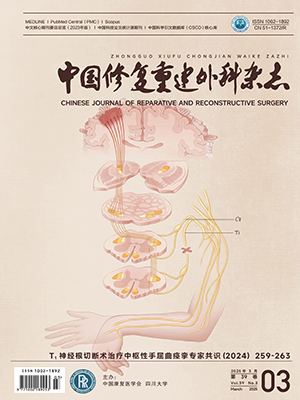Objective To investigate the feasibil ity, safety and operative techniques of percutaneous vertebroplasty (PVP) in treating osteolytic bone metastasis of cervical vertebra and reconstructing the function of cervical vertebra. Methods From March 2005 to December 2007, 10 patients with osteolytic bone metastatic carcinoma in single cervical vertebral body received PVP, including 5 males and 5 females aged 38-75 years (mean 54.5 years). Among them, 5 patients had primary lung tumor, 1 primary renal tumor, 1 primary breast tumor, 1 primary cervical tumor and 2 unknown primary lesion. The course of disease was 2-4 years. All the patients suffered from obviously cervical pain and l imitation of activity, including 4 cases of metastatic tumor of the C2 vertebral body, 2 of C3, 2 of C6 and 2 of C7. The general condition of patients was stable before operation, and no blood coagulation dysfunction, radiculalgia and spinal cord compression were detected. Lateral PVP was performed on 6 cases, approaching between the vertebral artery and the carotid sheath under CT guidance and anterolateral PVP was performed on the rest 4 cases, approaching between the trachea and the internal carotid artery under continuously X-ray fluoroscopy. The amount of bone cement injected was 3-4 mL, and the fill ing rate was 50%-100%. Results Without obvious bleeding or organ injury, the puncture was performed successfully on all the patients. Without symptom of spinal cord compression, patients suffered from pain during operation (1 case) and such compl ications noted by immediate CT or X-rays examination after operation as paravertebral epidural cement leakage (2 ases),
transverse foramen cement leakage (1 case) and pinhole reflux (3 cases). The pain of patients was improved to various degree postoperatively, the visual analogue scales score was (5.9 ± 1.2) points before operation, which was changed to (2.6 ± 1.2) points at 1 hour after PVP and (1.6 ± 1.3) points at 1 week after PVP, indicating there was a significant difference between pre- and postoperation (P lt; 0.05). During the regular follow-up at 1 week, 3 and 12 months after PVP, all patients had no dislocation of cervical vertebra body, spinal cord compression and paralysis. Five patients died from multiple organ failure due to primary tumor progression, including 3 cases at 6 months after PVP and 2 at 12 months after PVP, and the rest 5 patients’ cervical pain were under control, with sound functional recovery. Conclusion PVP can rel ieve pain quickly and reinforce the stabil ity of the vertebral body, and has sl ight compl ications; the lateral approach is safe and effective.
Citation: ZHANG Jie,HOU Mei,FEI Zejun,YOU Xin,LI Jun,LUO Yong,LIAO Zhengyin. CLINICAL OBSERVATION ABOUT PERCUTANEOUS VERTEBROPLASTY FOR OSTEOLYTIC METASTATIC CARCINOMA OF CERVICAL VERTEBRA. Chinese Journal of Reparative and Reconstructive Surgery, 2009, 23(2): 194-197. doi: Copy
Copyright © the editorial department of Chinese Journal of Reparative and Reconstructive Surgery of West China Medical Publisher. All rights reserved




